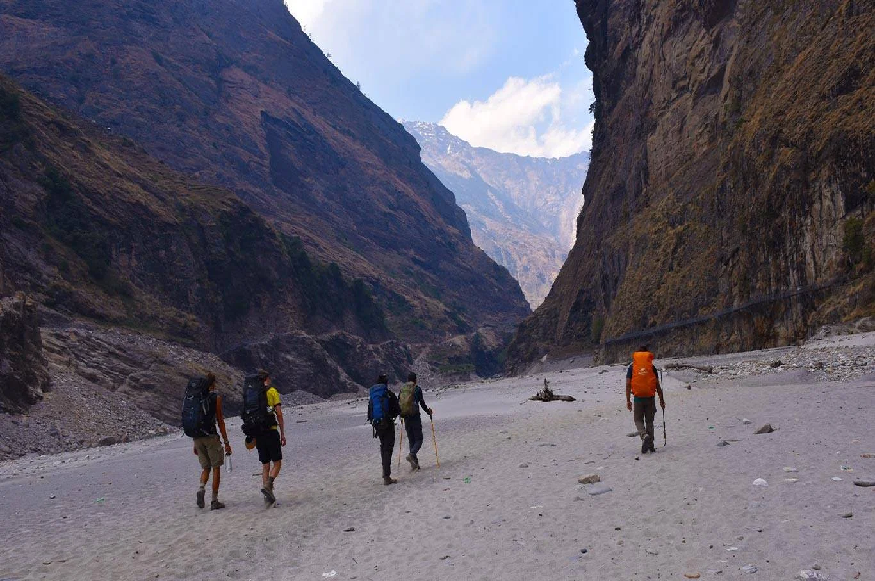Crossing Larke Pass: The Ultimate High Point Of The Manaslu Circuit

Hiking over Larke Pass is the highlight of the Manaslu Circuit Trek, providing trekkers with a life-defining adventure in the heart of the Himalayas. At 5,106m, Larke La is the highest point of the trek and offers a challenge of altitude as well as stamina and determination. The hike to the pass is physically demanding, with trekkers scrambling along steep, rocky paths and sometimes snowy ground. The air is thinned as you ascend, and it can be icy cold, yet this only adds to the adventure. Beginning as early as dawn, hikers wind their way up through tranquil alpine scenery, with the majestic crags of the Himalayas sweeping into view in the distance. The last slog up to the top is hard going, can easily last several hours, but closer to the pass, the views start to pay you back.
Manaslu Circuit Trek Difficulty. After reaching the top of the Larke Pass, the pass toward Larkey la, the views are outstanding. From the pass, you can see Himlung Himal, Cheo Himal, Kang Guru, and the huge Annapurna II. Seeing those giants there all lit up with snow shining in the sunlight, just takes your breath away, and sort of puts you in your place. The feeling of achievement and elation as you reach the top – a sense of having conquered one of the most imposing and altitude-demanding passes in Nepal – is overwhelming! The pass drops down into Bimthang in total contrast to the bare, wind-swept summit. On the way down, you drop down into green alpine meadows and forest (a pleasant break from the physical and mental effort of coming up). Larke Pass isn’t just the pinnacle of the Manaslu Circuit—it’s an intensely moving, unforgettable experience for trekkers that resonates long after they’ve left the mountains.
Overview of Larke Pass
Larke Pass, reaching a staggering 5,106 metres (16,752 feet), is one of the most legendary high points of the Manaslu Circuit trek in Nepal. Standing at the summit of the trek, it’s a physical and mental checkpoint for those ready to take on the challenge. The pass links the village of Samagaon to the village of Bhimtang and exhibits breathtaking panoramic views of some of the high-lying Himalayan features, such as Mount Manaslu, Himlung Himal, and Annapurna II.
The trek to Larke Pass is not for the fainthearted. The pass is a steep and high pass that challenges even the most experienced trekkers. It’s the kind of experience that most would only dream about, combining high-altitude trekking with trekking through the wilds of the Himalayas.
The Short Manaslu Circuit Trek is tough no doubt but the payoff is huge. Trekking parties experiencing mountain scenery around the pass are thrilled and filled with a sense of achievement as they stand at the top of the pass. The trail to Larke Pass is a very much a wild and off-the-beaten-track trek, leaving trekkers with that sense of adventure and discovery, and the journey to the pass becomes a pilgrimage, both physical and spiritual.
Significance of the Larke Pass on the Trek
Larke Pass is not only a physical obstacle, but also the highlight of the Manaslu Circuit trek, because it represents the focal point where the trail surpasses its highest point. With an altitude of 5,106 meters, this place serves as a major stopover on the trek and signals the end of a tough climb through the Manaslu region. For trekkers, trekking over Larke La is an experience of pride because it is a precise blend of everything that epitomizes Trekking in the isolated, unspoiled beauty of the Nepal Himalayas.
The pass is significant in the georagphical location since it lies on the border of two regions, the Manaslu Conservation Area and the Annapurna region. It offers trekkers a breathtaking view of snow-covered peaks like Mount Manaslu, Annapurna II and Himlung Himal – not only inspiring but a grim reminder of the majestic wilderness of the Himalayas.
Culturally, Larke Pass is a long-established route that’s been traveled over for centuries by local people. It’s one of the lifelines of the region for the villages of the Manaslu region and an arterial route for trade and commerce. So, Larke Pass isn’t simply a trekking objective – it is a part of the lives of the regional people, which provides an added dimension to the trek beyond the physical effort required to cross the pass.
Larke Pass Preparation and Training
Larke Pass is not an easy pass to cross, it requires a lot of physical and mental stamina. At 5,106 meters this is one of the high points on the Manaslu Circuit, and a tough one to tackle, even for the experienced trekkers. Preparation starts long before you even get to step foot on the trail and physical conditioning and not getting altitude sickness are the most crucial to a successful hike.
Manaslu Circuit Trek Start a training program a few months before you leave to get in the best shape, to protect yourself on your trip. Concentrate on developing cardiovascular strength by hiking, running, or cycling, which would aid in stamina. There is also strength training for the legs, the core, and the upper body, which will prepare you for the steep, rocky terrain you will have to cross on the trek. Hiking with a weighted pack is also good, as it gets you used to wearing your gear on your back.
Acclimatisation is key when trekking to higher altitudes, and Larke Pass is no different. Take a few days in villages at a lower altitude, like Samagao, before ascending to let your body acclimatize to the thinning air before crossing the pass. Water, behaving gradually, and hydration of the body are also recommended during the rush to reduce the likelihood of altitude sickness.
Mental preparation is just as important as physical preparation. The trip to Larke Pass is not only strenuous in terms of physical exertion but also some amount of mental strength is required. Knowing that the days are going to be long and strenuous, and that the Manaslu region is very remote can help significantly when it comes to being prepared mentally on how to do the trek.
Trekking Route to Larke Pass
The Larke Pass trek is an incredibly tough, yet ultimately rewarding, trek that takes trekkers on a journey through some of the most spectacular and isolated terrain that Nepal has to offer. The beginning of the journey is the village of Soti Khola, and trekkers walk through forests and terraced fields, gradually increasing altitude and reaching higher altitudes. Knocking off a handful of villages along the way, Jagat, Deng, and Namrung, for example, take in the traditional ways of life of the area’s ethnic groups like the Gurung and Tibetan tribes.
Tome a medida que aseñorentes, más montañosa es la tierra. The forests fade into alpine meadows, and the trail gets narrower, the climbing steeper, the footing more rocky, the air thinner. The trek goes through Samagaon, which is a must-stop for acclimatization and where trekkers halt for resting before heading for the tough climb to Larke Pass. The last section of the trek up to Larke Pass is the hardest as the trail is rocky and the snow on the ground makes the climb steep there in particularly in winter.
Trekkers are rewarded with panoramic views of the surrounding peaks, including Mount Manaslu, Himlung Himal, and Annapurna II, after reaching the pass. The drop down from Larke Pass to Bhimtang is just as beautiful, with stunning views of glacial valleys and high lounge country. The trek from start to finish up to Larke La is a once-in-a-lifetime opportunity to experience the perfect combination of natural grandeur and cultural wealth, and it is no surprise that it is one of the most popular routes through the Himalayas.
High-altitude issues and acclimation
The approach to Larke Pass involves a few treeless lateral valleys and several high passes that must be crossed. Larke Pass, at more than 5,100 meters (16,752 feet), is a challenging barrier that can bring on altitude sickness without adequate preparation. Altitude sickness happens when the body has difficulty adapting to the low levels of oxygen at higher altitudes, causing symptoms like lightheadedness, headaches, and vomiting.
Manaslu Circuit Trek Nepal To minimize the danger that comes with high-altitude trekking, acclimatizing is essential. Those making the trek ought to make a slow, steady climb over several days, allowing the body to acclimate to the thinning atmosphere. This trek features planned rest days in villages like Samagaon and Sama, held at altitudes close to 3,500 meters. These rest days will help trekkers acclimatise to the altitude and hopefully avoid altitude sickness.
Hydration, proper nutrition (a high carbohydrate diet a day before, during and after ascending ensures better performance at high altitude), and travelling at a gradual and easy pace (no brisk walking) are also important to minimize the effects of altitude. Playing yourself at high altitude can make you sicker, so trekkers should listen to their bodies, even if it means resting.
In the end, good preparation and proper acclimatization are necessary to get over the challenges of the Larke Pass. Those who spend a few days acclimatizing and slowly and steadily approach the pass will be rewarded with the prize of endless beauty and the psychological achievement that comes with reaching a high-altitude pass. The breathtaking views, the feeling of accomplishment, and the Himalayas’ beauty make the climb to Larke Pass a day you will never forget.
Weather Conditions and Best Time to Cross
The weather on Larke Pass may be erratic and wild as it is higher and open. The weather can change abruptly, clear skies morphing into heavy snows or winds sweeping torrents of snow in a matter of moments. As the pass is at more than 5,100 meters (16,752 feet) above sea level, in the early morning and late afternoon, temperatures can drop dramatically. The trail to Larke pass can be treacherous in the snow and ice of winter, or you could find the rain in the summer makes the path too slippery to traverse. Larke is best crossed in spring (March-May) and autumn (September-November) when the weather is relatively stable and clear. These months ensure favorable weather conditions and less risk of encountering snowstorms for trekkers, offering the best of the views and safe travel through the pass. Nevertheless, in the best seasons, it can snow, storm, rain, and be sunny, all on the same day. Cloud cover is rare in the morning and evenings, notwithstanding the season. The right equipment, such as layers, wet weather gear, and sun protection, is important for completing the trek to Larke Pass, as it allows you the best possible chance of adjusting to the different climates that you will likely face on the journey.
Scenic Beauty and Views from the Pass
Manaslu Circuit Trek Cost And Itinerary Transversing the Larke Pass is more than just a physical endeavor, as you are surrounded by some of the most jaw-dropping vistas that the Himalayas have to offer. As one climbs towards the pass, there is a gradual transition from alpine forest to rocky, desolate desert, with radical changes in scenery. At the summit of the pass is the spectacular panorama of Mount Annapurna, Annapurna Himal, Himlung Kakha, Ghyajaru Himal from the pass (2745m), Himlung Himal, Cheo Himal, Kang Guru, and Annapurna II, including descent down to Muktinath Valley. The scale is vast, and the beauty of the surrounding, jagged mountain ranges is both heart-stopping, with glaciers and jagged ridgelines as far as the eye can see. From here, the quiet is serene, the quiet of the high Himalayas lends an almost sacred touch. And when trekkers gaze out over those pristine vistas, it’s easy to see why Larke Pass is such a highlight of the Manaslu Circuit Trek. What’s special is not just the vastness of the vistas but the feeling of satisfaction that you’ve summited after hours of climbing. It’s a one contrast comes after another on the way down from the Tibet-like pass to the green of Bimthang, the lush green meadow like none you’ve seen below the harsh world at the top. The pass is so beautiful, tranquil, and some say that for miles around you won’t want to leave.
Safety Tips for You Crossing over Larke Pass
Getting across Larke Pass takes planning, it’s a tough, high-altitude trek. Safety is, of course, key, and trekkers should follow several precautions to make sure they make it to the finish line safely. So the number one rule is acclimatization. Since trekkers are vulnerable to acute mountain sickness, the 5,106-metre (16,752-foot) altitude of the pass is considered risky and potentially life-threatening without proper acclimatization. There is just no better way to acclimate while moving up, and that prepares your body for the less and less air as you go up. It’s also best to follow the “climb high, sleep low” rule, where you remain at higher altitudes during the day, but return to lower altitudes to sleep. Other key safety reminders are to expect the unexpected in terms of the weather. Weather at Larke Pass can be erratic – snowfall, high winds, and temperature changes. Trekkers should be equipped with appropriate gear, warm clothing, waterproof clothing, and sturdy boots. The pass can be difficult to navigate because of snow or ice, so it’s best to take an experienced guide who knows the area. Knowing the symptoms of altitude sickness — headaches, dizziness, nausea — is critical, and trekkers need to be willing to turn around if they experience any symptoms. For peace of mind, you should carry a first aid kit and have emergency evacuation resources. Safety is preparation, awareness, and knowing when to push forward and when to draw back.
Anecdotes and Experiences from the Trekkers
Manaslu Circuit Trek Map The personal narratives of those who have completed the trek and crossed Larke Pass invariably glow with a combination of awe and exhaustion, and beaming pride. They all say that making it to the top of the pass is one of the most valuable experiences of their trekking life. For others, though, the quest to Larke Pass is more than just a physical challenge; it’s a mental and emotional one, too, a trail that pushes people right to the extremes. The ascent to the pass is frequently characterized as a struggle against exhaustion and altitude sickness, but the 360-degree payoff at the top makes every weary mile worth it. The sense of surreal beauty when trekkers get to the pass is one they remember a lifetime— the sweeping expanse of the magnificent mountains as far as the eye could see, the eerie sense of silence, and the feeling of being on top of the world. Others write of the solidarity they forged with other trekkers and guides, because crossing Larke Pass is a shared accomplishment that brings trekkers from all over the world closer together. But the road is not all easy. The unreliable weather is cited by many trekkers, and you will need to be flexible as it changes fast, which can add a new layer of difficulty to the trek. Despite the difficulties, the camaraderie and the splendor of the scenery are enduring memories for everyone who attempts. Personal stories illustrate not just the physical struggle but the lasting emotional imprint of the trek, making The Trek an experience trekkers continue to carry with them long after they have left the mountains behind.
Conclusion: The Prize of Making It to Larke Pass
Larke Pass is more than a physical achievement; it is an adventurous voyage that gives us a sense of something beyond the imaginable, and trekkers get a combo of pride and duty fulfilled. The way to the pass is not easy – strength and stamina, and will power are required – but the view is unbeatable. At 5106 meters (16,752 feet), Larke Pass is one of the most stunning views of all surrounding peaks and valleys, as trekkers say it creates a sense of awe and is humbling. The feeling of relief and satisfaction bolstered by the experience of walking through this tall and difficult pass with surrounding natural beauty is one of the most unforgettable Manaslu Circuit Trek memories. Too many reaching the Larke Pass is the icing on the cake after days of hard walking, where each step becomes a sweet sense of achievement. Apart from the physical feat, the emotional triumph is enormous as the pass is not just the conclusion of a challenging trek but a bridge between trekkers and the unbridled nature of the Himalayas. It is a space for contemplating the beauty, solitude, and power that come with trekking in the mountains. It’s a light at the end of the tunnel, an example of the strength and fortitude of human beings, and the benefits of slogging on through. A never-to-be-forgotten moment for those who love adventure and nature, gaining the Larke Pass is a testimony to the magnificence and difficulty of the Himalayas.
What is the highest point of the Manaslu Circuit trek?
The highest point of the Manaslu Circuit Treks Nepal is the Larke Pass, which is located at an altitude of 5,106 meters (16,752 feet). This pass is the climax of the trek and is one of the most treasured highlights of the trip. Situated in the Nepalese Himalayas, it links the Samdo area of the mountain with Bimthang Mountain. The route to Larke Pass is tough, with walkers having to negotiate steep, rocky trails and, at times, snow-covered ground. Ascending trekkers will sense a dramatic change in height and weather pattern, the air will turn thinner, and the temperature will drop considerably as you approach the pass. The views from the crest of Larke Pass will be the most rewarding, for in the trek, trekkers can see incredible views of Himlung Himal, Annapurna II, and Kang Guru. Achieving the pass is one of the most rewarding moments of this 7-day adventure, after some challenging days trekking.
How hard is the Larke Pass?
Common Knowledge The Larke pass is one of the most challenging trekking passes in Nepal, testing the strength and mentality of the trekker. The ascent to the pass can be tough, with trekkers climbing over rocky, snow-covered, and, on occasion, slippery ground. Altitude, which peaks at 5,106 meters (16,752 feet), is an additional challenge, as the thinning air can make it harder to breathe, leading to fatigue and shortness of breath.” On account of its elevation, trekkers must make sure that they are fully acclimatized to avoid altitude sickness. The pass is cold, and usually involves harsh weather – trekkers must come armed with the appropriate attire. The last push up to Larke La is typically made in the early hours to try to get over the top and down the other side before the afternoon snowstorms, and the effort needed to crest it pushes physical and mental boundaries. Demanding, the pass offers exceptional views to hikers with a strong sense of accomplishment.
How high is Larke Pass?
The highest point on the Manaslu Circuit Trek is Larke Pass (5,106m / 16,752ft). The pass is an important head point for the trek, joining the high-altitude region of Samdo and the greener valleys above Bimthang. This is a tough climb for trekkers – not just a steep climb, but the altitude as well. The air at more than 16,400 feet is considerably thinner and can cause altitude sickness for trekkers who are not well acclimated. The views from the Larkya Pass are among the best on the trek, a 360-degree panorama of mountains including Himlung Himal, Cheo Himal, and Annapurna II. It’s commonly considered the most stunning high-altitude trek in Nepal.
How difficult is the Manaslu Circuit trek?
Manaslu Circuit Trek is known to be a moderately difficult trek that requires endurance and mental toughness. It is a tough trek on account of the high altitude, erratic weather, rough ground, and the requirement for trekkers to ascend and descend fairly steep inclines for extended periods. Though it lacks the technical challenges of a few other high treks, the route traverses through a range of tough terrain, from lush forests and river valleys to rocky trails as well as snowy passes, particularly while crossing Larke Pass. The high altitudes, especially around the Larke Pass at over 5,000m, necessitate acclimatization to prevent altitude sickness. The trek is also longer than some of the other popular routes, taking about between 14 to 18 days, adding to the overall difficulty. But the rewards are great: stunning landscapes; the opportunity to access Tibetan Buddhist culture in a remote corner of (formerly) unknown Tibet; and the exhilaration of having completed this loop. It is not as challenging as the Everest Base Camp Trek and other extreme routes, but the Manaslu Circuit is a serious test of strength and stamina for any trekker.
Is Manaslu harder than Everest?
The Manaslu Circuit Trek Cost is a difficult one, but it doesn’t have to be harder than a trek to Everest Base Camp. The two expeditions have high-altitude and physical demands in common, but they are contrasted by terrain, duration, and technical challenges. The Everest Base Camp trek is the most popular option and is well-developed, has more facilities along the trek, and has easier road access. Manaslu, however, is a more remote and less saturated circuit, with more challenging terrains and fewer teahouses. It also demands a longer acclimatization to the higher altitude and the climb over the Larke pass (5,106 metres / 16,752 feet).
Although you trek to an extreme elevation for the base camp of Mount Everest, the Mount Everest Base Camp Trek is relatively easier considering better infrastructure, better acclimatization possibilities, and shorter walking days. Whereas Manaslu Circuit is strenuous because of its rocky trails, where there are no teashops and a distant trek. The challenge of the two treks is, of course, concerning the individual trekker’s own experience and fitness. For more experienced trekkers with a desire for more off-the-beaten-path adventure, the Manaslu Circuit is slightly harder but infinitely more satisfying than the relatively more accessible Everest Base Camp trek.






